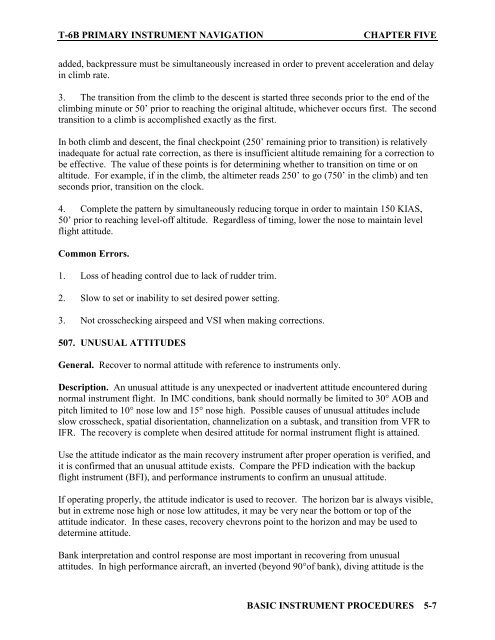Flight Training Instruction - Cnatra - U.S. Navy
Flight Training Instruction - Cnatra - U.S. Navy
Flight Training Instruction - Cnatra - U.S. Navy
Create successful ePaper yourself
Turn your PDF publications into a flip-book with our unique Google optimized e-Paper software.
T-6B PRIMARY INSTRUMENT NAVIGATION CHAPTER FIVE<br />
added, backpressure must be simultaneously increased in order to prevent acceleration and delay<br />
in climb rate.<br />
3. The transition from the climb to the descent is started three seconds prior to the end of the<br />
climbing minute or 50’ prior to reaching the original altitude, whichever occurs first. The second<br />
transition to a climb is accomplished exactly as the first.<br />
In both climb and descent, the final checkpoint (250’ remaining prior to transition) is relatively<br />
inadequate for actual rate correction, as there is insufficient altitude remaining for a correction to<br />
be effective. The value of these points is for determining whether to transition on time or on<br />
altitude. For example, if in the climb, the altimeter reads 250’ to go (750’ in the climb) and ten<br />
seconds prior, transition on the clock.<br />
4. Complete the pattern by simultaneously reducing torque in order to maintain 150 KIAS,<br />
50’ prior to reaching level-off altitude. Regardless of timing, lower the nose to maintain level<br />
flight attitude.<br />
Common Errors.<br />
1. Loss of heading control due to lack of rudder trim.<br />
2. Slow to set or inability to set desired power setting.<br />
3. Not crosschecking airspeed and VSI when making corrections.<br />
507. UNUSUAL ATTITUDES<br />
General. Recover to normal attitude with reference to instruments only.<br />
Description. An unusual attitude is any unexpected or inadvertent attitude encountered during<br />
normal instrument flight. In IMC conditions, bank should normally be limited to 30° AOB and<br />
pitch limited to 10° nose low and 15° nose high. Possible causes of unusual attitudes include<br />
slow crosscheck, spatial disorientation, channelization on a subtask, and transition from VFR to<br />
IFR. The recovery is complete when desired attitude for normal instrument flight is attained.<br />
Use the attitude indicator as the main recovery instrument after proper operation is verified, and<br />
it is confirmed that an unusual attitude exists. Compare the PFD indication with the backup<br />
flight instrument (BFI), and performance instruments to confirm an unusual attitude.<br />
If operating properly, the attitude indicator is used to recover. The horizon bar is always visible,<br />
but in extreme nose high or nose low attitudes, it may be very near the bottom or top of the<br />
attitude indicator. In these cases, recovery chevrons point to the horizon and may be used to<br />
determine attitude.<br />
Bank interpretation and control response are most important in recovering from unusual<br />
attitudes. In high performance aircraft, an inverted (beyond 90°of bank), diving attitude is the<br />
BASIC INSTRUMENT PROCEDURES 5-7
















